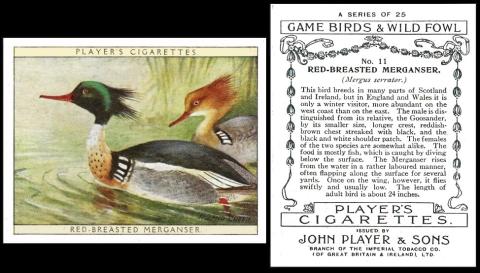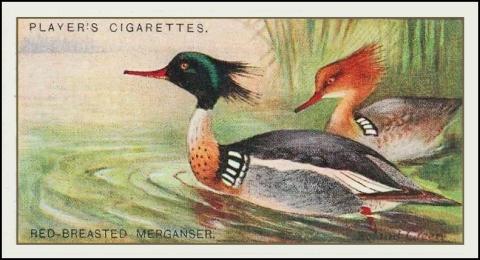
Closing our week, we have this lovely pair of Mergansers, also known as Goosanders, though, oddly, Merganser is more commonly used in America - in Europe and Asia we tend to prefer to call it a Goosander. It mainly eats fish, and lives on rivers and lakes, especially in forested areas, where it can make its nests in the trees.
We know that the bird was known to the Romans, and that they called it Mergus, a name which was borrowed in the 18th century by Carl Linnaeus, who gave it the name of Mergus Merganser. The "anser" part actually means goose, which is almost certainly where the Goosander comes from, but there is no connection genetically with the goose family. It seems likely, therefore, that it simply refers to the fact that it is a large duck, and similar to a goose in size.
And it is very likely that this pair was drawn, from life, in Norfolk.
This set has two sizes, which are catalogued in our original John Player booklet, RB.17, published in 1950, as :
- 105. GAME BIRDS AND WILD FOWL. Subjects designed by Roland Green, F.Z.S. Fronts in colour. Backs in grey with descriptive text. Home issues.
A. 50 Small cards. Issued June 1927
B. 25 Large cards, Issued November 1928.
The small size are much more readily available. Curiously the smaller cards actually fit more of the picture in, this one having been trimmed to the sides, removing half the brown duck and some of the rippling water. Because of this, the "PLAYER`S CIGARETTES" and "RED BREASTED MERGANSER", which appears in the picture of the small card, on the left hand side, where the excision took place, has been removed on the large one, instead being placed in two light coloured borders, the "Player`s" at the top and the duck`s name at the bottom.
Roland Green, Fellow of the Zoological Society,.was born in Rainham, in Kent, on the 9th of January, 1890. His father was a taxidermist, who taught his son all about the anatomy of birds. However, he did not want to follow that trade, he wanted, instead, to be a painter, and more than that, to paint directly from life rather than from photographs, or from taxidermy, which was the norm at that time, neither of which he felt gave a true representation of the birds. Later on he moved to Hickling, in Norfolk, to a houseboat, which allowed him to observe birds all about him. He also came across a disused mill, Hickling Broad Mill - which is now, locally, often referred to as Roland Green's Mill. He then continued to live on the boat and use the mill as a studio, until he built himself a little bungalow/studio nearby.
He never married, and lived, quite alone, amongst the Broads, until he died, on the 18th of December, 1972. And he was buried in the local churchyard.

